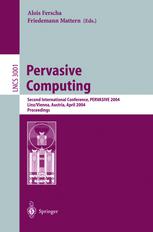

Most ebook files are in PDF format, so you can easily read them using various software such as Foxit Reader or directly on the Google Chrome browser.
Some ebook files are released by publishers in other formats such as .awz, .mobi, .epub, .fb2, etc. You may need to install specific software to read these formats on mobile/PC, such as Calibre.
Please read the tutorial at this link: https://ebookbell.com/faq
We offer FREE conversion to the popular formats you request; however, this may take some time. Therefore, right after payment, please email us, and we will try to provide the service as quickly as possible.
For some exceptional file formats or broken links (if any), please refrain from opening any disputes. Instead, email us first, and we will try to assist within a maximum of 6 hours.
EbookBell Team

4.8
14 reviewsnd Welcome to the proceedings of PERVASIVE 2004, the 2 International C- ference on Pervasive Computing and the premier forum for the presentation and appraisal of the most recent and most advanced research results in all - undational and applied areas of pervasive and ubiquitous computing. Consi- ring the half-life period of technologies and knowledge this community is facing, PERVASIVE is one of the most vibrant, dynamic, and evolutionary among the computer-science-related symposia and conferences. The research challenges, e?orts, and contributions in pervasive computing have experienced a breathtaking acceleration over the past couple of years, mostly due to technological progress, growth, and a shift of paradigms in c- puter science in general. As for technological advances, a vast manifold of tiny, embedded, and autonomous computing and communication systems have st- ted to create and populate a pervasive and ubiquitous computing landscape, characterized by paradigms like autonomy, context-awareness, spontaneous - teraction, seamless integration, self-organization, ad hoc networking, invisible services, smart artifacts, and everywhere interfaces. The maturing of wireless networking, miniaturized information-processing possibilities induced by novel microprocessor technologies, low-power storage systems, smart materials, and technologies for motors, controllers, sensors, and actuators envision a future computing scenario in which almost every object in our everyday environment will be equipped with embedded processors, wireless communication facilities, and embedded software to perceive, perform, and control a multitude of tasks and functions.